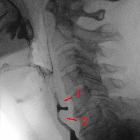pharyngocele



Pharyngocele, lateral pharyngeal diverticulum of in non permanent, only intradeglutitiv cases lateral pharyngeal pouche, refers to a lateral pharyngeal wall herniation in the piriform recess or in a vallecula.
Epidemiology
Pharyngoceles are rare and more often unilateral than bilateral . It is commonly associated with occupational exposure to increased intra-pharyngeal pressure such as glass blowing or playing musical woodwind or brass instruments. It occurs more frequently in males than in females and usually arises during the fifth and sixth decades of life .
Clinical presentation
The majority of patients are asymptomatic . The primary manifestation is dysphagia but other clinical features may include :
- neck mass
- regurgitation
- odynophagia
- dysphonia
- otalgia
- cervical pain
- hoarseness
- cough
- weight loss
Pathology
The two main factors involved in the pathogenesis of pharyngoceles are chronic elevation of intrapharyngeal pressure and pharyngeal wall weakness .
Most documented cases in the medical literature have an association with the repeated elevation of intrapharyngeal pressure. Patients are typically glassblowers or musicians who play woodwind or brass instruments .
Pharyngocoeles can arise from two areas of weakness on the lateral wall of the pharynx .
Loss of muscle elasticity with aging and previous surgeries can contribute to the wall weakness . A minority of patients have congenital causes thought to be due to branchial cleft anomalies .
Risk factors
Raised intrapharyngeal pressure secondary to :
- playing woodwind or brass instruments
- glass blowing
- excessive cough
Radiographic features
Ultrasound
Pharyngocoeles can be seen on a transverse sonogram at the level of the ventricular folds as ahyperechoic air pocket which should enlarge during a Valsalva maneuver . In pharyngoceles, air communicates with piriform sinuses distinguishing it from laryngoceles which have air communicating with laryngeal saccules . Identification of pharyngoceles on ultrasound can be difficult in the presence of thyroid calcification .
Plain radiograph / Fluoroscopy
Pharyngocoeles are best identified on the frontal barium swallow X-ray during a Valsalva maneuver before and after contrast administration. In bilateral pharyngoceles, a "bullfrog appearance" can be appreciated on frontal cervical X-rays .
CT
CT scan and laryngoscopy are the diagnostic tools of choice . Similar to the X-ray, it is best appreciated during a Valsalva maneuver after ingestion of a positive oral contrast . It is typically seen as a parapharyngeal air sac that communicates with the base of the piriform sinus or the lateral side of the vallecula .
MRI
Morphologically is similar to findings on CT. Dynamic real-time and 3D MRI can allow for better visualization of the anatomy, specific location and characteristics of the lesion .
Treatment and prognosis
Treatment is usually conservative involving healthy dietary habits, oral hygiene, avoiding activities that increase intrapharyngeal pressure and wearing a compressive neck wrap while doing those activities . Surgical excision may be indicated in severely symptomatic patients .
Differential diagnosis
- laryngocele
- Zenker’s diverticulum
- jugular vein phlebectasia
Siehe auch:
- Zenker-Divertikel
- Killian-Jamieson-Divertikel
- Laryngozele
- Pulsionsdivertikel
- Killian-Pouches
- Divertikel und Pouches des Pharynx
und weiter:

 Assoziationen und Differentialdiagnosen zu Pharyngozele:
Assoziationen und Differentialdiagnosen zu Pharyngozele:





